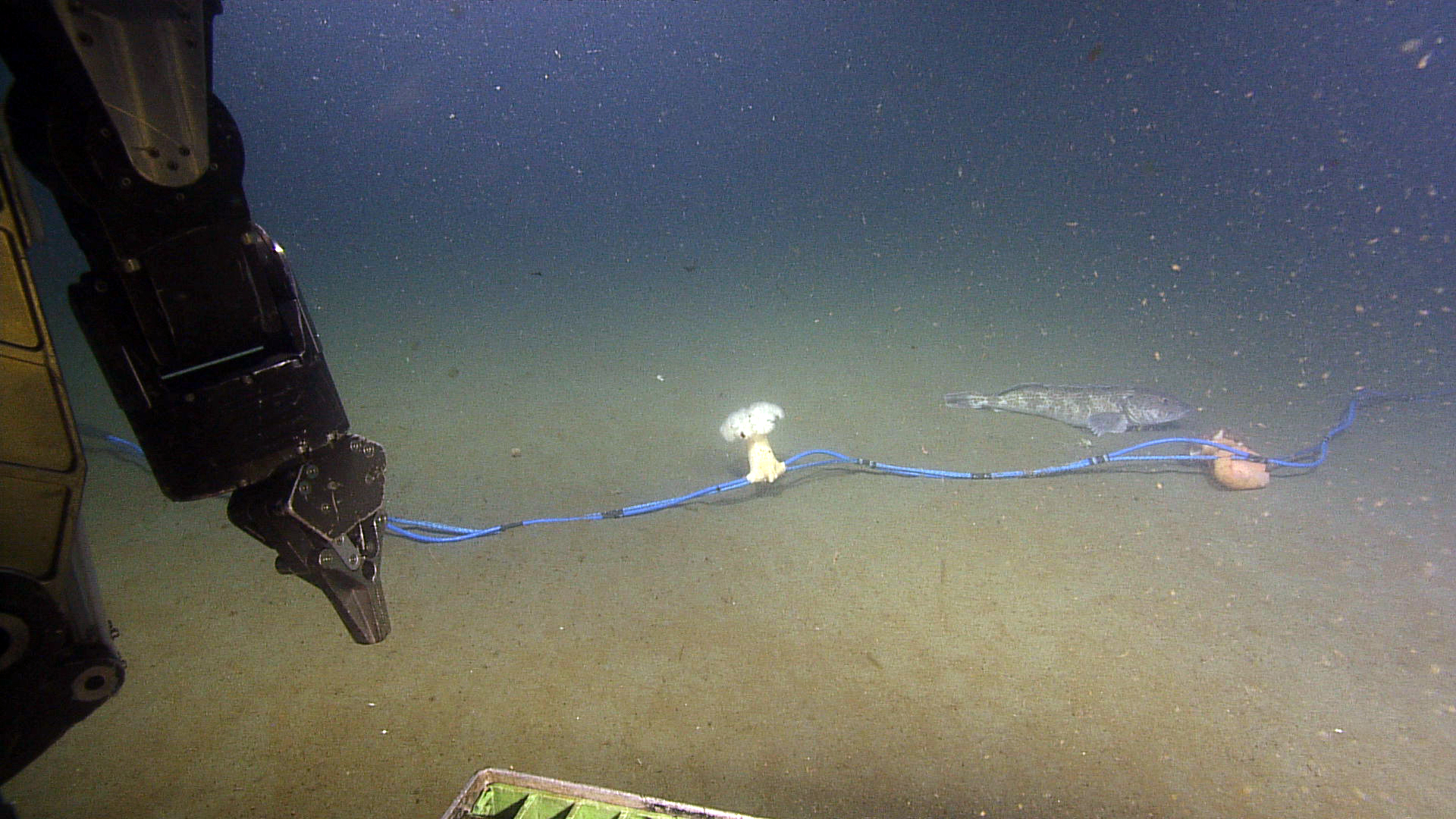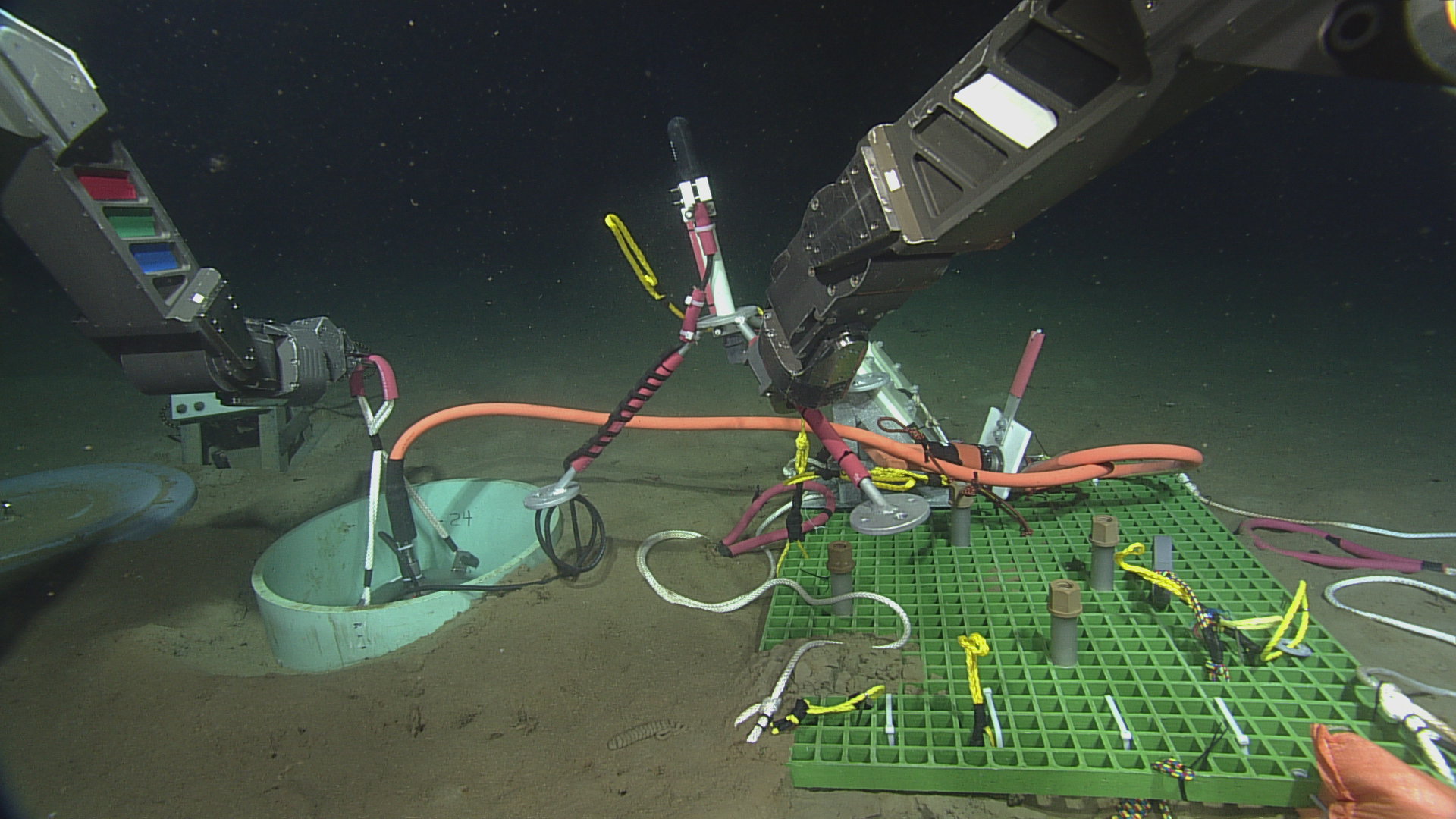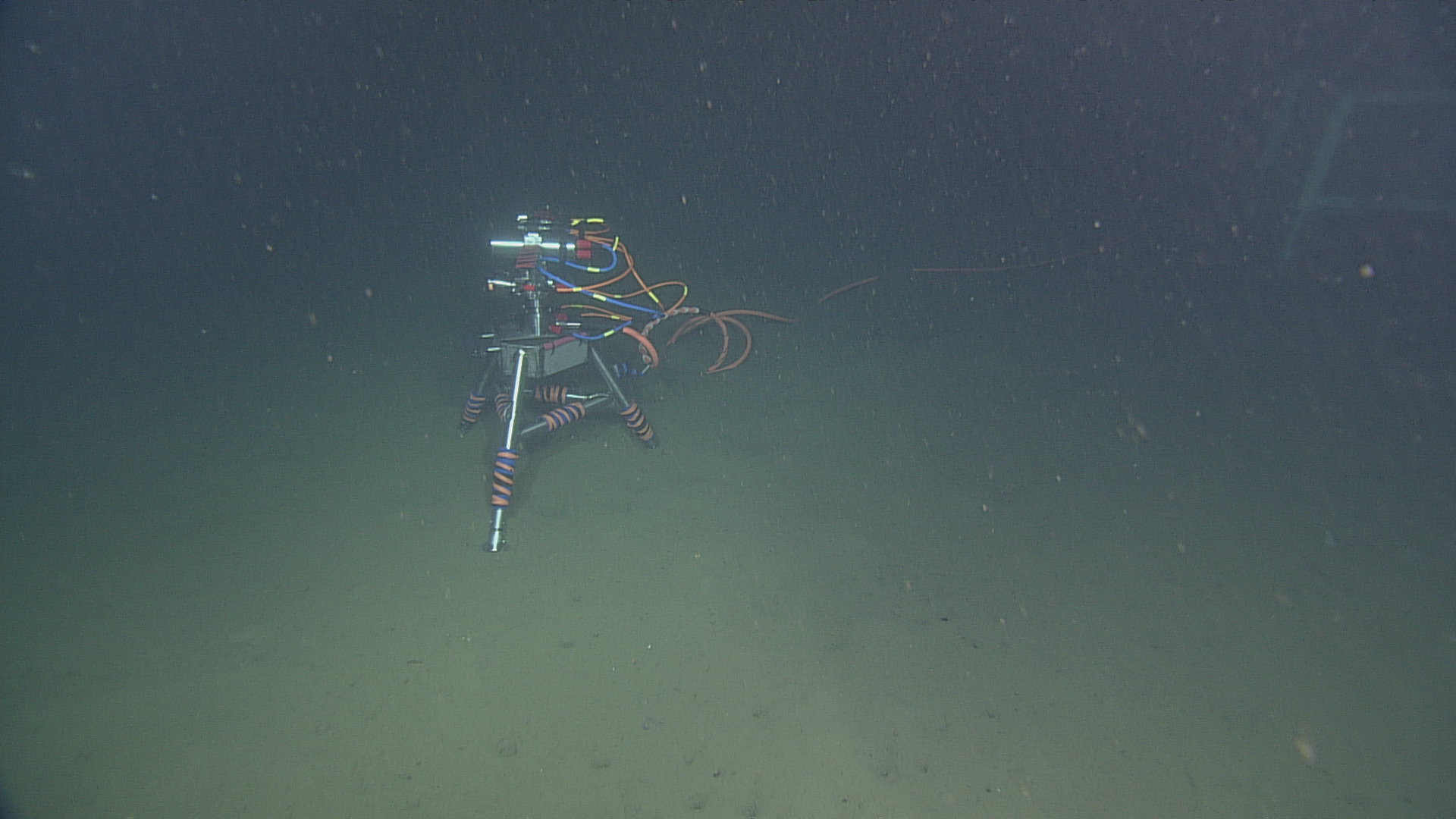Image Archive





























The hydrophone (an underwater microphone) connected to the Benthic Experiment Package (BEP) at the Oregon Shelf site, in 80 meters of water. Photo Credit: NSF/UW/CSSF, Dive R1801, V14

A lingcod resting on the seafloor next to the hydrophone cable at the Oregon Shelf (80m) site. Photo Credit: NSF/UW/CSSF, Dive R1801, V14

The cabled coastal surface-piercing profiler (cCSPP) was delivered to the seafloor by ROPOS and placed roughly 12 meters due East of the medium-powered junction box MJ01C at the Oregon Shelf site, in 79 meters of water. The cylindrical sensor pod of the cCSPP (left side of image) will float freely in the water column after being released from the deployment cradle on the profiler base. Once powered up, the sensor pod will move up and down in the water column at least 4 times per day, taking samples continuously using the onboard CTD, oxygen, fluorometer, nitrate, AC-S, PAR sensor, spectral irradiance, and 3D water velocity sensors. Photo Credit: NSF/UW/CSSF, Dive R1801, V14

A lingcod and two anemones attached to the Oregon Shelf hydrophone cable. Photo Credit: NSF/UW/CSSF, Dive R1801, V14

An orange anemone clinging to the hydrophone cable at the Oregon Shelf site. The hydrophone was only deployed roughly a week before, so this anemone found the hard substrate and attached itself fairly quickly. Photo Credit: NSF/UW/CSSF, Dive R1801, V14

ROPOS using the starboard manipulator to pull the release that allowed the sensor pod of the cabled coastal surface-piercing profiler (cCSPP) to swing upwards and float freely in the water. The cCSPP was delivered to the seafloor and placed roughly 12 meters due East of the medium-powered junction box MJ01C at the Oregon Shelf site, in 79 meters of water. Photo Credit: NSF/UW/CSSF, Dive R1801, V14

The sensor pod of the cabled coastal surface-piercing profiler (cCSPP) floating freely in the water column after being released from the deployment cradle on the profiler base. Once powered up, the sensor pod will move up and down in the water column at least 4 times per day, taking samples continuously using the onboard CTD, oxygen, fluorometer, nitrate, AC-S, PAR sensor, spectral irradiance, and 3D water velocity sensors. Photo Credit: NSF/UW/CSSF, Dive R1801, V14

A crab and snailfish encountered during a site survey between the Endurance Oregon Offshore 2-legged mooring EOM leg anchor and the low-voltage node LV01C. The scaling laser dots are 10 cm apart. Photo Credit: NSF-OOI/UW/CSSF, Dive R1752, V14

A sea pen encountered during a site survey between the Endurance Oregon Offshore 2-legged mooring EOM leg anchor and the low-voltage node LV01C. Photo Credit: NSF-OOI/UW/CSSF, Dive R1752, V14

An eelpout fish encountered during a site survey between the Endurance Oregon Offshore 2-legged mooring EOM leg anchor and the low-voltage node LV01C. Photo Credit: NSF-OOI/UW/CSSF, Dive R1752, V14

A snail with an anemone on its shell, one of several encountered during a site survey between the Endurance Oregon Offshore 2-legged mooring EOM leg anchor and the low-voltage node LV01C. Photo Credit: NSF-OOI/UW/CSSF, Dive R1752, V14

A hagfish and black cod encountered during a site survey between the Oregon Offshore Shallow Profiler Mooring EOM leg anchor and the low-voltage node LV01C. Credit: UW/NSF-OOI/CSSF, ROPOS Dive R1752, V14.

All deployed Slope Base infrastructure connected to primary node PN1A. Photo Credit: NSF-OOI/UW/CSSF, Dive R1751, V14

ROPOS lowering the Slope Base seismometer into the previously excavated caisson. After deployment, the caisson was filled with glass beads to couple the seismometer to the seafloor. The attached hydrophone tripod is being held in the starboard arm of ROPOS, and was deployed alongside. Photo Credit: NSF-OOI/UW/CSSF, Dive R1751, VISIONS14

A pair of hermit crabs (possibly mating?) at Hydrate Ridge, near Einstein's Grotto. Photo Credit: NSF-OOI/UW/CSSF, Dive R1750, V14

Replacing the caisson cover at Southern Hydrate Ridge, after inspecting the eventual deployment location of a seismometer at that site. The caisson (the hole in the sediment at center) was excavated using a suction tube attached to the ROV during a previous expedition. Credit: UW/NSF-OOI//CSSF, ROPOS ROPOS Dive R1750, V14.

A beautiful soft coral attached to hard substrate at Southern Hydrate Ridge, near Einstein's Grotto. Photo Credit: NSF-OOI/UW/CSSF, Dive R1750, V14

The hydrophone tripod connected to the BEP at the Endurance Oregon Offshore site. The hydrophone is an underwater microphone listening for marine mammal vocalizations, anthropogenic noise, and other acoustic signals. It is offset from the BEP site by ~10 meters to reduce background noise. Photo Credit: NSF-OOI/UW/CSSF, Dive 1747, V14

A catshark (Apristurus) encountered during a cable survey at the Oregon Offshore site (585 meters depth). Photo Credit: UW/NSF-OOI/CSSF, ROPOS Dive 1747, V14.

The digital still camera deployed the Oregon Offshore site (600 m). Photo Credit: UW/NSF-OOI/CSSF, ROPOS Dive 1747, V14.

The digital still camera in the ROPOS toolbasket during deployment at the Oregon Offshore site (600 m); the camera at is designed to look at the seafloor in general, observing animal activity, sediment transport, detritus falls, and bioturbation. Credit: UW/NSF-OOI/CSSF, Dive 1747, V14.

The Benthic Experiment Package on the seafloor at Endurance Oregon Offshore, connected to the low-voltage node LV01C by the cable extending under the protective doors. The oxygen sensor is visible on the left side, and the 3D velocimeter and ADCP can be seen on the top left and right (respectively). Photo Credit: NSF-OOI/UW/CSSF, Dive 1747, V14

Primary Node PN1C provides power and bandwidth to the Oregon Offshore site (600 m). Because it is in shallow waters, it hosts a 'trawl resistant' frame - here with the protective doors closed. Credit: UW/NSF-OOI/CSSF, ROPOS Dive 1747, V14.

Removing the hydrophone tripod from the Benthic Experiment Package (BEP) during deployment at Oregon Offshore site (600 meters depth). The hydrophone was moved ~8 meters away to avoid picking up noise from the other sensors in the BEP. Credit: UW/NSF-OOI/CSSF, ROPOS Dive 1745, V14.

The Benthic Experiment Package (BEP) deployed at the Offshore site (600 meters depth) and plugged into low-voltage node LV01C. Photo Credit: UW/NSF-OOI/CSSF, ROPOS Dive 1745, V14.

Seafloor cable RS01W9 and strain relief carabiners connected to the low-voltage node LV01C at the EOffshore site, 600 meters deep.Photo Credit: UW/NSF-OOI/CSSF, ROPOS Dive 1744, V14.

ROPOS connecting the P2 end of seafloor cable RS01W9 into the J1 port on LV01C. RS01W9 runs between PN1C and LV01C at the Endurance Offshore site, 600 meters deep. Photo Credit: NSF-OOI/UW/CSSF, Dive 1744, V14

Primary Node PN1C 1 km from the Oregon Offshore site ais home to numerous crabs. Credit: UW/NSF-OOI/CSSF, ROPOS Dive 1743, V14.
- Anemone
- Animal
- Arthropod
- ASHES
- Axial
- Axial Base
- Axial Biology
- Axial Caldera
- Bacteria
- Basalt Lava
- BEP
- Biofouling
- biolgoy
- Biology
- Camds
- Camera
- Camhd
- Central Caldera
- Ciliates
- Cnidaria
- Coastal Biology
- Crab
- Deep Profiler Mooring
- Dive Highlights
- Eastern Caldera
- Echinoderms
- Endurance Array
- Engineering Team
- ENLIGHTEN 10
- Exploratorium
- Fish
- Geology
- HD Camera
- HPIES
- Hydrate Ridge
- Hydrates
- Hydrophone
- Hydrothermal Vents
- Illustration
- Inshore 80 Meters
- Instrument
- International District
- J-BOX
- Jason
- Jellyfish
- Junction Box
- K12
- Lava
- Mollusk
- Moorings
- Nodes
- Nudibranch
- Octopus
- OOI
- Oregon Offshore
- Oregon Offshore 600 m
- Oregon Shelf
- Oregon Slope Base
- People
- PN1B
- PN1D
- Polychaetes
- PPSDN
- Primary Node
- RASFL
- ROCLS
- ROPOS
- ROPOS Dives
- ROV Team
- RV Revelle
- RV Sikuliaq
- RV Thompson
- Salp
- Sample
- SC13
- Science Team
- Sea Cucumber
- Sea Star
- Sea Urchin
- Seafloor
- Seismometer
- Sensors
- Shallow Profiler Mooring
- Shark
- Shipboard
- Shore Station
- Slope Base
- Smoker
- Soft Coral
- Southern Hydrate Ridge
- Sponge
- Squid
- Students
- Students & Guest Participants
- Tmpsf
- Tubeworms
- VISIONS 11 Leg 1
- VISIONS 11 Leg 2
- VISIONS 11 Viewers
- VISIONS 13
- VISIONS 14
- VISIONS 15
- VISIONS 16
- VISIONS 17
- VISIONS 18
- VISIONS 20
- VISIONS 22
- VISIONS 23
- Visualization
